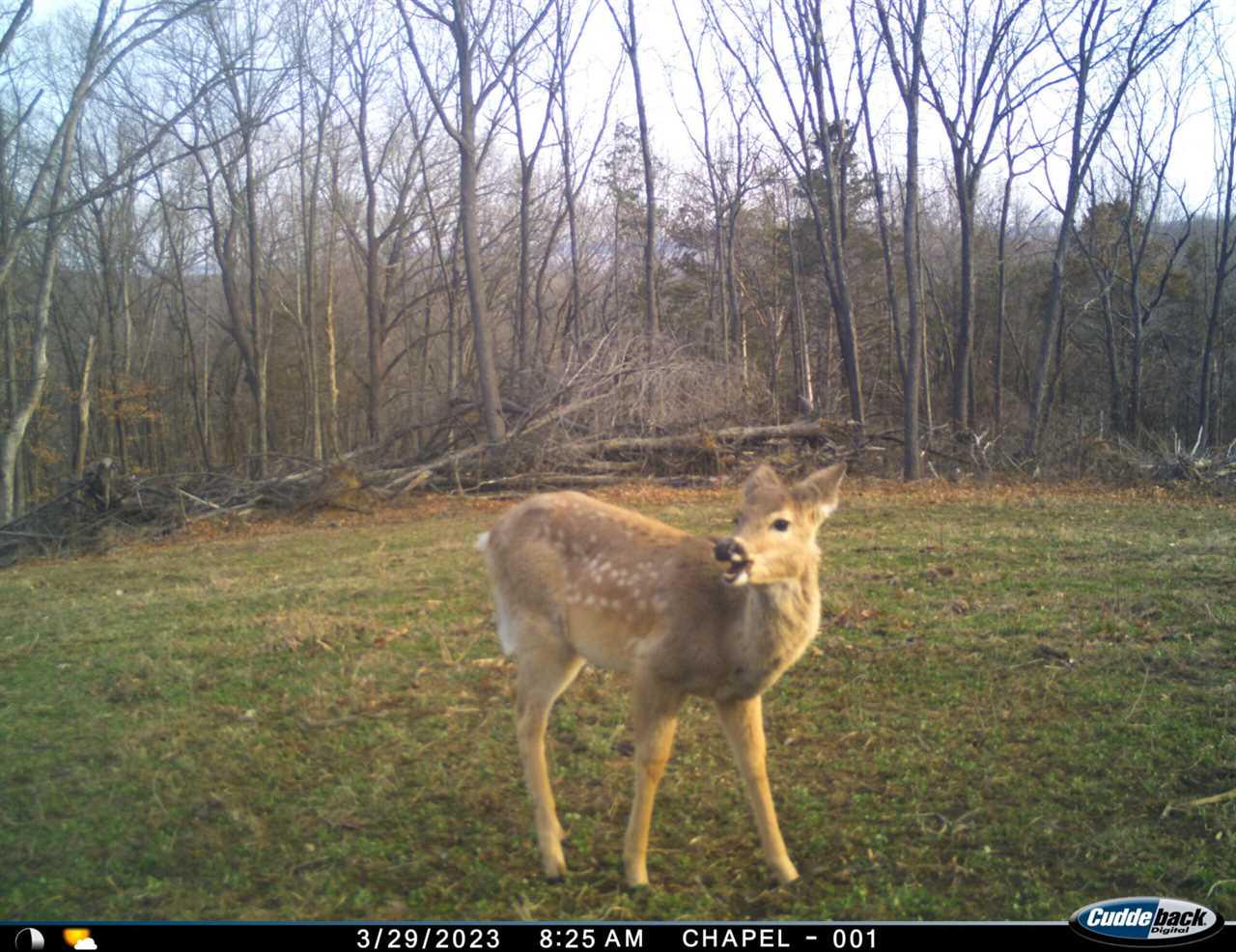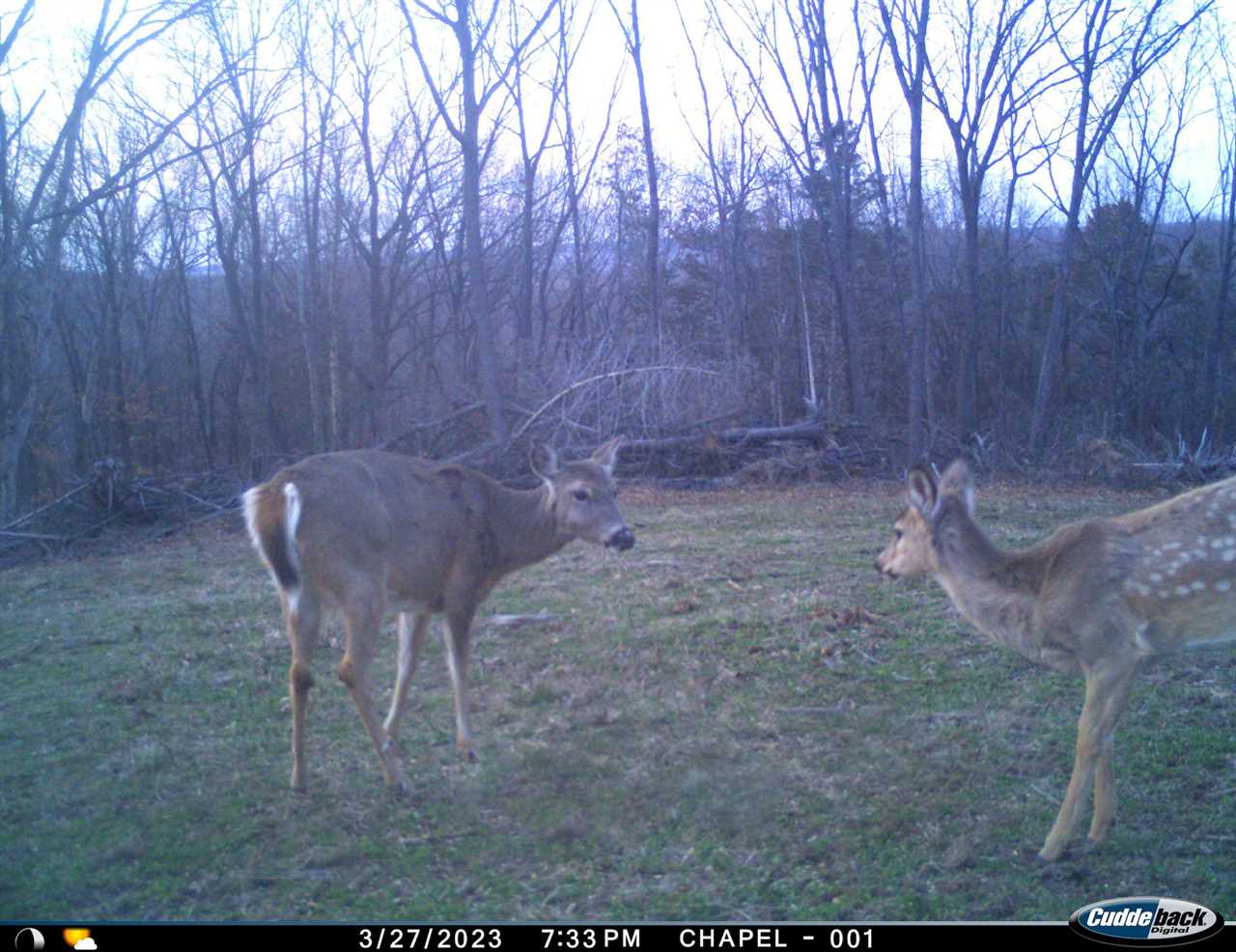This whitetail fawn was photographed in Missouri on March 27. Rick Dahl / NDA
A trail camera on National Deer Association chairman Rick Dahl’s Missouri property recently photographed a deer that would make most hunters do a double-take. The naked trees and the correct trail-cam timestamp tell us it’s late March. But the large whitetail fawn in the photos is on the verge of shedding a winter coat that’s still covered in spots.
As most deer hunters know, whitetail fawns are normally born in May and June. Their spots last for five or six months, disappearing as deer seasons open. Fawns have developed these spots over millennia of evolution to camouflage with dappled sunlight filtering through leafy trees, NDA director of conservation Matt Ross tells Outdoor Life. Fawns usually shed those spots as trees begin to shed their leaves in the fall. But the fawn photographed on March 27 looks to be about four months old, Ross estimates, which means it was likely born in late November and probably conceived in May.
“That’s way out of whack in terms of when we know the rut to be,” Ross says, noting that the peak rut in that part of whitetail country is usually late October through early to mid-November.

Fawns usually lose their spots by the fall, when they’re around six months old. Rick Dahl / NDA
Does go into their first estrous cycle not when they reach a certain age, but after they reach a certain size—around 70 to 80 pounds. Ross thinks this fawn’s mother could have been born in the spring or summer of 2021 as is normal, but was quick to reach reproductive size. So she could have conceived during her first estrous cycle in spring 2022 instead of in fall 2022. She would have dropped her fawn in November, roughly 200 days later.
But that means the buck that bred such an early doe also acted uncharacteristically.
“Generally, bucks are not interested in breeding that time of year,” Ross explains, noting that male and female deer spend most of their time apart. “Breeding is driven by the amount of daylight in the 24-hour period, and at that time of year, there’s quite a bit of daylight. So it’s unusual to find a buck that wants to breed [at that time]. It’s possible that it was a younger buck, but that’s a complete guess.”

This fawn was likely birthed much later in the year, NDA’s Matt Ross says. Rick Dahl / NDA
Whitetail deer have evolved to give birth when food sources are most abundant, since adequate nutrition allows a doe to produce plenty of milk for its offspring. For a newborn fawn to enter the world without quality forage and then survive its first winter is surprising, Ross says. In this instance, a warmer-than-average winter in Missouri might have made all the difference.
“Think about when the average deer is born. In April or May, everything is green, there’s food available for the doe to eat to produce a lot of milk, and then those newborn deer have a maximum amount of time to grow before their first winter sets in,” Ross explains. “It would be rare for a deer to survive outside that timeline. Deer born out of cycle traditionally might not have made it because of food, nutrition, or predators. They’d typically succumb to something. But there must have been something that let that fawn in the photo make it.”
While it’s hard to determine the sex of the fawn from the photos alone, Ross guesses that if it’s a female, it will likely enter its own estrous cycle at a relatively normal time of year. Research has shown that, when something funky happens in an animal’s development that can impact the chronology of its life cycle, that hiccup eventually corrects itself. In this case, the fawn’s growth was likely stunted by a difficult first four months.
“I don’t think this fawn would continue to go into estrus in the spring. It won’t be completely out of whack,” Ross says. “It will eventually sync up with the rest of the deer.”
If you come across a deer on your own trail camera that seems out of sync with the rest of the local herd’s timeline, Ross says to not be shocked.
Read Next: It’s Okay (and Sometimes Necessary) to Shoot Does with Fawns During Hunting Season
“There is some strange stuff in the deer world. A lot of people like deer because they are truly charismatic megafauna,” he says. “There are a lot of eyes paying attention to a lot of deer. There are some crazy anomalies and lots of opportunity to be in awe.”
The post Trail Cam Captures a Whitetail Fawn Born in November? appeared first on Outdoor Life.
Articles may contain affiliate links which enable us to share in the revenue of any purchases made.
By: Katie Hill
Title: Trail Cam Captures a Whitetail Fawn Born in November?
Sourced From: www.outdoorlife.com/conservation/whitetail-fawn-born-november/
Published Date: Tue, 04 Apr 2023 22:20:52 +0000
----------------------------------------------
Did you miss our previous article...
https://manstuffnews.com/weekend-warriors/wild-game-power-rankings-what-species-have-the-best-shot-at-surviving-climate-change
 Backyard GrillingWeekend WarriorsAdvice from DadBeard GroomingTV Shows for Guys4x4 Off-Road CarsMens FashionSports NewsAncient Archeology World NewsPrivacy PolicyTerms And Conditions
Backyard GrillingWeekend WarriorsAdvice from DadBeard GroomingTV Shows for Guys4x4 Off-Road CarsMens FashionSports NewsAncient Archeology World NewsPrivacy PolicyTerms And Conditions
